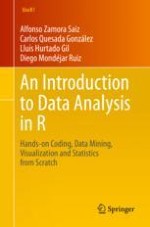This textbook offers an easy-to-follow, practical guide to modern data analysis using the programming language R. The chapters cover topics such as the fundamentals of programming in R, data collection and preprocessing, including web scraping, data visualization, and statistical methods, including multivariate analysis, and feature exercises at the end of each section. The text requires only basic statistics skills, as it strikes a balance between statistical and mathematical understanding and implementation in R, with a special emphasis on reproducible examples and real-world applications. This textbook is primarily intended for undergraduate students of mathematics, statistics, physics, economics, finance and business who are pursuing a career in data analytics. It will be equally valuable for master students of data science and industry professionals who want to conduct data analyses.
